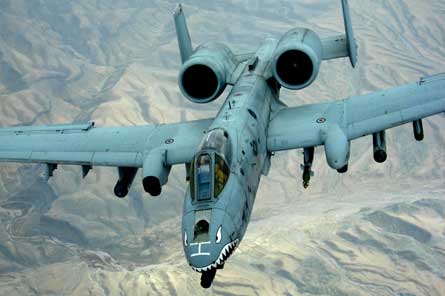The US Air Force may seek to retain and continuously upgrade its Fairchild A-10 fleet far beyond its currently planned retirement date of 2028. "There are bigger numbers throwing around that are much [later] than that," Air Combat Command chief of requirements Lt Col Ralph Hansen told Flight International on 21 August.
Armed with a nose-mounted 30mm cannon, the A-10 was first deployed in 1976 to destroy enemy tanks, but its mission has been expanded since the end of the Cold War to also include close air support duties and co-operating with special forces for combat search and rescue purposes.
The programme has in the past faced sceptics within the air force's leadership, with then-Maj Gen David Deptula reportedly having asked a subordinate to draft a memorandum justifying the retirement of the A-10 fleet in April 2003, with the invasion of Iraq still in progress. This effort was dropped after a highly publicised backlash and in 2004 the service announced a new plan to re-engine the A-10 fleet and upgrade the aircraft to use precision-guided weapons.
 |
|---|
© US Air Force |
The so-called "Super Hog" plan fell apart a year later when the air force killed funds for the re-engining plan, but a separate precision engagement programme was awarded to Lockheed Martin to upgrade all 356 A-10s with digital weapon stores, multifunction displays, the situational awareness datalink and smart weapons such as Boeing's GBU-38 JDAM. The first redesignated A-10Cs will make their combat debut in September, following a crash effort to accelerate the precision engagement programme by 18 months.
The air force also plans to replace the thin-skin wings on about 250 A-10s with a more robust wing structure, and awarded a $2 billion contract to Boeing in July to complete the modifications. A wide range of additional upgrades may also still be in store for the A-10, ranging from new networks, additional weapons and reviving the engine upgrade proposal.
Roger Il Grande, Lockheed's precision engagement programme manager, believes integrating new networks tops the priorities list, with the Link 16 and Tactical Targeting Networking Technology considered candidates.
The programme also is reviewing options for installing the Lockheed AGM-114 Hellfire air-to-surface missile, says Hansen. The air force has meanwhile proposed reviving production of Raytheon's laser-guided AGM-65E Maverick missile, as A-10 squadrons have been forced to acquire the missiles from the US Navy for operational needs.
Hansen says the Air Combat Command will also reconsider inserting funds for the General Electric TF-34 engine upgrade kit in the next five-year spending plan starting in fiscal year 2010.
Related stories:
Source: Flight International























